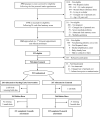Randomized controlled trial of an early child obesity prevention intervention: Impacts on infant tummy time
- PMID: 28332324
- PMCID: PMC5404992
- DOI: 10.1002/oby.21779
Randomized controlled trial of an early child obesity prevention intervention: Impacts on infant tummy time
Abstract
Objective: To describe infant activity at 3 months old and to test the efficacy of a primary care-based child obesity prevention intervention on promoting infant activity in low-income Hispanic families.
Methods: This study was a randomized controlled trial (n = 533) comparing a control group of mother-infant dyads receiving standard prenatal and pediatric primary care with an intervention group receiving "Starting Early," with individual nutrition counseling and nutrition and parenting support groups coordinated with prenatal and pediatric visits. Outcomes included infant activity (tummy time, unrestrained floor time, time in movement-restricting devices). Health literacy was assessed using the Newest Vital Sign.
Results: Four hundred fifty-six mothers completed 3-month assessments. Infant activity results were: 82.6% ever practiced tummy time; 32.0% practiced tummy time on the floor; 34.4% reported unrestrained floor time; 56.4% reported ≥1 h/d in movement-restricting devices. Inadequate health literacy was associated with reduced tummy time and unrestrained floor time. The intervention group reported more floor tummy time (OR 2.16, 95% CI 1.44-3.23) and unrestrained floor time (OR 1.69, 95% CI 1.14-2.49) compared to controls. No difference in the time spent in movement-restricting devices was found.
Conclusions: Tummy time and unrestrained floor time were low. Primary care-based obesity prevention programs have potential to promote these activities.
Trial registration: ClinicalTrials.gov NCT01541761.
© 2017 The Obesity Society.
Conflict of interest statement
Figures
Comment in
-
Early infancy interventions to prevent childhood obesity.Obesity (Silver Spring). 2017 May;25(5):817-818. doi: 10.1002/oby.21829. Epub 2017 Mar 23. Obesity (Silver Spring). 2017. PMID: 28337849 No abstract available.
References
-
- Hesketh KD, Crawford DA, Abbott G, Campbell KJ, Salmon J. Prevalence and stability of active play, restricted movement and television viewing in infants. Early Child Dev Care. 2015;185(6):883–894.
-
- Downing KL, Hnatiuk J, Hesketh KD. Prevalence of sedentary behavior in children under 2 years: A systematic review. Prev Med. 2015;78:105–114. - PubMed
Publication types
MeSH terms
Associated data
Grants and funding
LinkOut - more resources
Full Text Sources
Other Literature Sources
Medical


